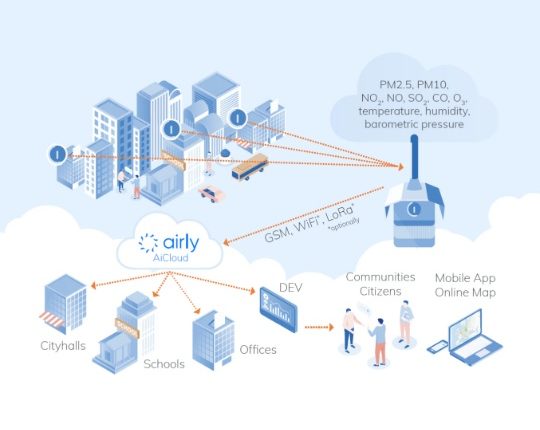
In many countries located in the temperate climate zone, smog is a seasonal phenomenon strongly related to heating. Is there any way to reduce your emissions in winter without investing in photovoltaics? Let’s take a closer look at the most common heating methods and their pros and cons. Below, you’ll find some tips how to choose the best quality coal if you cannot give up on it at the moment.
Burning fossil fuels is the main source of particulate matter and toxic gases in the atmosphere. It’s not only the issue of carbon dioxide that contributes to climate change to the greatest extent. Fossil fuel exploitation is also responsible for the rising carbon oxide, sulphur dioxide, and nitrogen oxide emissions. When it’s burnt, the aromatic hydrocarbons and soot accumulate in the air, in some cases causing the formation of toxic smog.
Observing the data delivered by the air pollution sensor from the temperate climate areas, it’s hard not to notice the correlation between heating and air pollution. How could this problem be solved?
Heating vs. photovoltaics
Using photovoltaics and becoming partially or even fully self-sufficient is a dream scenario that is becoming increasingly popular among people concerned with climate change and other environmental issues. And indeed, if we all switched to solar, the emissions of greenhouse gases and particulate matter could drop significantly.
However, it’s not that easy nor efficient as it’s often presented. First – choosing such a solution, at least for now, requires some compromises. The off-grid installation has limited capacity, and without a battery – which is not environmentally friendly due to the usage of lithium and quite expensive – it cannot provide the household with energy all the time since it depends on sunlight.
Solar energy is undoubtedly the most democratic and efficient renewable we can choose, and due to the development of technologies (for example, perovskite), it will become even more accessible. However, it is understandable that many household owners – at least for now – consider it not efficient enough to cover their electricity demand, particularly in the winter season.
Hopefully, we’ll experience a green transformation on a global scale quite soon. It’s probable that in the following decades, most of the electricity in the power grid will come from solar and other renewable sources. But what can you do meanwhile, when heating the house in winter?
Does the quality of coal matter?
Yes – when the coal is low-quality, more harmful substances reach the atmosphere while it’s burning. We don’t mean carbon dioxide – its emissions remain high regardless of the quality. However, the sulphur dioxide and aromatic hydrocarbons emissions do depend on that factor.
If you have to use coal, consider choosing a better quality product – not only for the sake of eco-friendliness but also for higher efficiency. Today, the norms regulate this issue, but you can still choose the best option available on the market. Pay attention to the size of coal pieces – the bigger they are, the better. Also, verify its level of humidity and the content of ashes – if they’re high, the quality of coal is much worse.
If you want to see how the emissions of the fossil-fuel-tied polluting particles and gases are now in your region, check Airly.org. You can also install the air pollution sensor yourself to have everything under control.


Comments are closed.